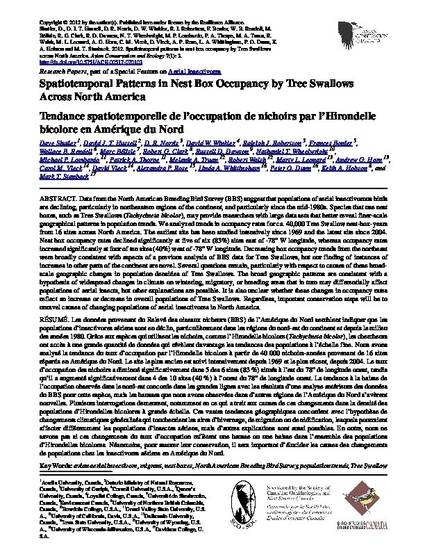
Article
Spatiotemporal Patterns in Nest Box Occupancy by Tree Swallows Across North America
Avian Conservation & Ecology
Document Type
Article
Disciplines
Publication Version
Published Version
Publication Date
1-1-2012
DOI
10.5751/ACE-00517-070103
Abstract
Data from the North American Breeding Bird Survey (BBS) suggest that populations of aerial insectivorous birds are declining, particularly in northeastern regions of the continent, and particularly since the mid-1980s. Species that use nest boxes, such as Tree Swallows (Tachycineta bicolor), may provide researchers with large data sets that better reveal finer-scale geographical patterns in population trends. We analyzed trends in occupancy rates for ca. 40,000 Tree Swallow nest-box-years from 16 sites across North America. The earliest site has been studied intensively since 1969 and the latest site since 2004. Nest box occupancy rates declined significantly at five of six (83%) sites east of -78° W longitude, whereas occupancy rates increased significantly at four of ten sites (40%) west of -78° W longitude. Decreasing box occupancy trends from the northeast were broadly consistent with aspects of a previous analysis of BBS data for Tree Swallows, but our finding of instances of increases in other parts of the continent are novel. Several questions remain, particularly with respect to causes of these broad-scale geographic changes in population densities of Tree Swallows. The broad geographic patterns are consistent with a hypothesis of widespread changes in climate on wintering, migratory, or breeding areas that in turn may differentially affect populations of aerial insects, but other explanations are possible. It is also unclear whether these changes in occupancy rates reflect an increase or decrease in overall populations of Tree Swallows. Regardless, important conservation steps will be to unravel causes of changing populations of aerial insectivores in North America.
Copyright Owner
The author(s)
Copyright Date
2012
Language
en
File Format
application/pdf
Citation Information
Dave Shutler, David J.T. Hussell, D. R. Norris, David W. Winkler, et al.. "Spatiotemporal Patterns in Nest Box Occupancy by Tree Swallows Across North America" Avian Conservation & Ecology Vol. 7 Iss. 1 (2012) p. 3 Available at: http://works.bepress.com/carol-vleck/13/

This article is from Avian Conservation & Ecology 7:1 (2012); article 3, doi: 10.5751/ACE-00517-070103. Posted with permission.